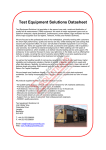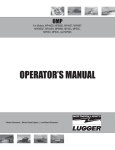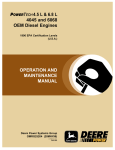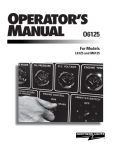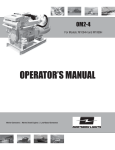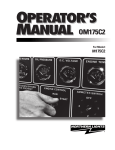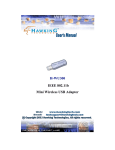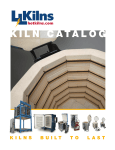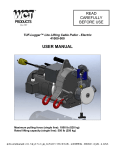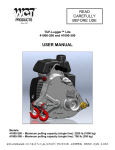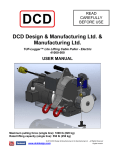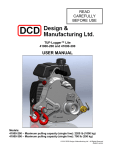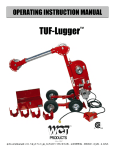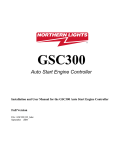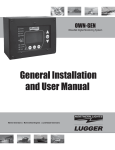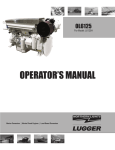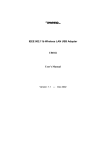Download OPERATOR`S MANUAL
Transcript
OL2-2 For Models: L1064D, L1064A, L1066T, and L1066A OPERATOR’S MANUAL Marine Generators | Marine Diesel Engines | Land-Based Generators OL2-2 06/10 1 — CALIFORNIA — Proposition 65 Warning: Diesel engine exhaust and some of its constituents are known to the State of California to cause cancer, birth defects, and other reproductive harm. Northern Lights 4420 14th Avenue N.W. Seattle, WA 98107 Tel: (206) 789-3880 Fax: (206) 782-5455 Copyright ©2010 Alaska Diesel Electric, Inc. All rights reserved. Northern Lights™, and the Northern Lights logo are trademarks of Northern Lights, Inc. Printed in U.S.A. PART NO.: OL2-2 1/10 OL2-2 06/10 2 OPERATOR'S MANUAL #OL2-2 for Models L1064D, L1064A, L1066T, and L1066A Read this operator's manual thoroughly before starting to operate your equipment. This manual contains information you will need to run and service your new unit. Table of Contents INTRODUCTION ....................................................2 Models Included .................................................2 Model Numbers ..................................................2 Serial Numbers ...................................................2 Turbocharger .................................................... 22 Turbo Boost ..................................................... 22 Cooling System - General ................................ 22 Engine Coolant Specifications ................. 22 - 23 Cooling System Flushing ................................. 24 Heat Exchanger Cleaning ................................ 24 Zinc Electrodes ................................................ 24 Raw Water Pump ............................................. 25 Electrical System - General ............................. 25 Booster Batteries .............................................. 26 Battery Care ..................................................... 26 Winterizing / Out-of-Service ........................... 26 WARRANTY ............................................................3 SAFETY RULES .....................................................3 COMPONENT LOCATIONS ...........................4 - 5 LUGGER CONTROL PANELS.......................6 - 7 OPERATING PROCEDURES Before Starting ....................................................8 Shutdown Procedures .........................................8 Break-In Period ...................................................9 TROUBLESHOOTING Electrical .......................................................... 27 Engine ...................................................... 28 - 29 SPECIFICATIONS 1064 ................................................................. 30 1066 ................................................................. 31 SERVICING SCHEDULE CHART .............10 - 11 SERVICING Lubrication - General ....................................... 13 Checking Oil .................................................... 13 Oil Changes ..................................................... 13 Changing Oil Filter .......................................... 13 Air Filter .......................................................... 13 Valve Clearances .............................................. 14 Fuels - General ................................................. 15 Fuel Filters ....................................................... 15 Crankshaft Vibration Damper .......................... 15 Bleeding the Fuel System ................................ 16 Injector Service ........................................ 16 - 17 Injection Pump ......................................... 18 - 21 WIRING DIAGRAMS Lugger DC Electrical ............................... 32 - 38 ON-BOARD SPARE PARTS.............................. 39 Proprietary Information This publication is the property of Northern Lights, Inc. It may not be reproduced in whole or in part without the written permission of Northern Lights, Inc. © Northern Lights, Inc. All rights reserved. Litho U.S.A. Publication number OL2-2 1/10 OL2-2 06/10 1 Revised page 3-2-10 Introduction Failures begin with minor problems that are overlooked and become amplified when not corrected during routine maintenance. Servicing of marine engines and generator sets presents unique problems. In many cases boats cannot be moved to a repair facility. Marine engines cannot be compared to the servicing of automobiles, trucks or even farm equipment. Failures often occur in remote areas far from competent assistance. Marine engines are taxed far more severely than auto or truck engines; therefore, maintenance schedules must be adhered to more strictly. As operator, it is your obligation to learn about your equipment and its proper maintenance. This is not a comprehensive technical service manual. Nor will it make the reader into an expert mechanic. Its aim is to aid you in maintaining your unit properly. Model Numbers Model numbers give the unit's application, block model, aspiration, and RPM: 1064 or 1066 L L - Lugger marine propulsion engine + L1064D L1064A = = D, T , or A Lugger model number 106 mm bore, 4 cylinder or 106 mm bore, 6 cylinder Lugger® naturally aspirated marine propulsion engine with a John Deere Powertech Tier II 4045 engine block, with a mechanically controlled fuel system. Lugger® aftercooled marine propulsion engine with a John Deere Powertech Tier II 4045 engine block, with a electronically controlled fuel system. + D - Naturally aspirated T - Turbocharged A - Aftercooled L1066T = Lugger® turbocharged marine propulsion engine with a John Deere Powertech Tier II 6068 engine block, electronically controlled fuel system. L1066A = Lugger® aftercooled marine propulsion engine with a John Deere Powertech Tier II 6068 engine block, electronically controlled fuel system. Serial Numbers When referencing Northern Lights, Inc. equipment by serial number, please refer only to the number stamped on the Northern Lights® or Lugger® serial number plate. OL2-2 06/10 2 Warranty A warranty registration certificate is supplied with your set. It entitles the original purchaser of our equipment to a warranty covering material or assembly faults. The extent of coverage is described in the Limited Warranty Statement. We recommend that you study the statement carefully. NOTE: If the warranty is to apply, the servicing instructions outlined in this manual must be followed. If further information is needed, please contact an authorized dealer or the factory. Safety Rules CAUTION: Accident reports show that careless use of engines causes a high percentage of accidents. You can avoid accidents by observing these safety rules. Study these rules carefully and enforce them on the job. • Use caution in handling fuel. Never refuel a hot or running engine. Do not smoke while filling fuel tank or servicing fuel system. • Never leave engine without proper security. • Turn the coolant tank cap slowly to relieve pressure before removing. Add coolant only when the engine is stopped and cool. • Keep your hands, feet, hair and clothing away from power-driven parts. • Mount a fire extinguisher near engine. • Check for any loose electrical connections or faulty wiring. • Always disconnect the battery ground strap before making adjustments. • Engines should be operated only by knowledgeable, qualified personnel. • Operate engines in properly ventilated areas. • Keep trash and other objects away from engine. • Look completely around engine to make sure that everything is clear before starting. • Escaping fluids under pressure can penetrate your skin. Use a piece of cardboard or wood, not your hands, to search for leaks. • Avoid wearing loose clothing without a belt when working around engines. • Do not operate an engine that isn't in proper working order. If an unsafe operating condition is noted, tag the set and control panel so others will also know about the problem. • Do not oil or grease engine while it is running. • Provide first aid kits. • Always disconnect the ECU (Electronic Control Unit) connectors and remove the ground connection for the engine control system-tomachine frame before welding on engine. Make sure no other electronic components are in the ground path also. CALIFORNIA Proposition 65 Warning: CAUTION: This symbol is used throughout this book to alert you to possible danger areas. Please take special notice of these sections. Diesel engine exhaust and some of its constituents are known to the State of California to cause cancer, birth defects, and other reproductive harm. OL2-2 06/10 3 Lugger Component Locations Figure 1 & 2: L1064D 1. 2. 3. 4. 5. 6. Expansion Tank Coolant Fill Exhaust Manifold Air Cleaner Dry Exhaust Elbow Marine Gear 7. 8. 9. 10. 11. 12. Oil Pan Injection Pump Mounting Foot Heat Exchanger Zincs Heat Exchanger Rocker Arm Cover 13. 14. 15. 16. 17. 18. OL2-2 06/10 4 Alternator Raw Water Pump Dipstick Starter Fuel Filter Oil Filter Lugger Component Locations Figure 3 & 4: L1066T 1. 2. 3. 4. 5. 6. Expansion Tank Coolant Fill Dry Exhaust Elbow Turbocharger Air Cleaner Gear Filter 7. 8. 9. 10. 11. 12. Gear Output Flange Gear Dipstick Marine Gear Mounting Foot Starter ECU (Electronic Control Unit) 13. 14. 15. 16. 17. Second Alternator (Optional) Gear Oil Cooler Exhaust Manifold Alternator Belt Guard (2nd Alternator optional) OL2-2 06/10 5 18. 19. 20. 21. 22. Oil Pan Dipstick Oil Filter Fuel Filter Intake Manifold Lugger Control Panel Figure 5: Lugger Powerview Control Panel 1. TACHOMETER The key must be kept in the on or first position while the engine is running. Turn the key counterclockwise as far as possible to stop the engine. The tachometer shows the engine speed in revolutions per minute (RPM). Numbers are multiples of 100. 2. HOUR METER Note: Optional flybridge panels have engine start switches instead of key switches. Keeps track of the engine running time. 3. DC VOLTMETER When the engine is stopped, the voltmeter shows the condition of the battery, When the engine is running, it indicates the voltage output of the alternator. 4. KEY SWITCH 5. POTENTIOMETER Dims the panel lights. 6. ALARM HORN Shut down engine if possible and investigate immediately. 7. COOLANT TEMPERATURE GAUGE Turning the key clockwise to the first position will switch on the current. continue turning the key clockwise to start the engine. When the engine starts, immediately turn the key back to 8. the first position while the engine is running. Water temperature gauge shows the temperature of the cooling water. If the gauge registers over 200° or drops below 140°, stop the engine and investigate. OIL PRESSURE GAUGE The oil pressure gauge shows the oil pressure in the engine lubricating system. If the pressure drops below 15 PSI at a speed higher than idling, stop the engine immediately. OL2-2 06/10 6 Added page 01/15/10 Lugger Control Panel 2 1 11 3 10 4 9 8 7 6 5 Figure 2: Lugger Instrument Control Panel 1. TACHOMETER The tachometer shows the engine speed in revolutions per minute (RPM). Numbers are multiples of 100. 5. STOP BUTTON Stops engine immediately. 6. INSTRUMENT PANEL LIGHTING The switch turns on the instrument panel lights. 2. HOUR METER Keeps track of the engine running time. 7. OIL PRESSURE FAULT LIGHT Indicates low oil pressure. 3. DC VOLTMETER When the engine is stopped, the voltmeter shows the condition of the battery, When the engine is running, it indicates the voltage output of the alternator. 8. ENGINE TEMPERATURE FAULT LIGHT Indicates engine is over-heating. Activates in conjunction with alarm horn. 9. ALARM HORN 4. KEY SWITCH Turning the key clockwise to the first position will switch on the current. continue turning the key clockwise to start the engine. When the engine starts, immediately turn the key back to the first position while the engine is running. The key must be kept in the on or first position while the engine is running. Shut down engine if possible and investigate immediately. 10. COOLANT TEMPERATURE GAUGE Water temperature gauge shows the temperature of the cooling water. If the gauge registers over 200° or drops below 140°, stop the engine and investigate. 12. OIL PRESSURE GAUGE The oil pressure gauge shows the oil pressure in the engine lubricating system. If the pressure drops below 15 PSI at a speed higher than idling, stop the engine immediately. Note: Optional flybridge panels have engine start switches instead of key switches. OL2-2 06/10 7 Operating Procedures Operating 1. Check oil pressure as soon as the engine has started. Oil pressure should be above 15 PSI. The engine must never be run if the oil pressure is below 15 PSI. 2. Check the voltmeter. It should read 13 to 14 volts (26 to 28 volts for 24 volt systems) at 60°F (16°C). 3. Water temperature should not rise over 200°F (94°C). If it does, shut down the engine and investigate the cause of overheating. 4. Do not exceed 800 RPM when shifting marine gear. Repeated shifts at higher engine speeds can damage the reverse gear. 5. If the proper propeller is used, the engine should reach its approximate RPM’s at full throttle. If the maximum rated RPMs for your engine application is exceeded at full throttle, then your propeller is too small. If you cannon reach your maximum rated RPMs at full throttle, either your propeller is too large or bottom growth is slowing the boat. 6. To establish maximum cruising RPM: establish the RPM at full throttle and subtract 200-300 RPM. This will promote engine life and reduce fuel consumption. BEFORE STARTING 1. Check the water level by removing the pressure cap from the expansion tank. In order to give the cooling water room to expand, the level should be about 1 3/4 in. (4-5 cm) below the filler cap sealing surface when the engine is cold. When filling with coolant, the venting cock on top of the turbocharger should be opened to ensure that no air pockets form in the cooling system (see Service Point #13). CAUTION: Use protective clothing and open the filler cap carefully when the engine is warm to prevent burns. 2. Check the oil level in the crankcase with the dipstick. The oil level should be between the “waffled area” and the “oo”. Never allow the level to go below the “oo”. Always add the same viscosity of oil as is already in the crankcase (see Service Point #1). 3. Check the fuel tank level and open any fuel valves. 4. Disengage clutch, if equipped. 5. Close the seacock, check and clean the strainer and reopen the seacock. 6. Place the battery switch in the ON position. NOTE: The battery switch must always be kept ON while the engine is running. If the switch is turned OFF while the engine is running, the battery charging regulator could be ruined. Shutdown 1. Run engine three to five minutes in neutral at 1000 RPM, for cool down period. 2. Return engine to low idle. 3. Turn the key switch counterclockwise as far as possible to stop the engine. 4. Close the sea cock and fuel valves and put the battery switch in OFF position. Starting 1. Put the gear control in the neutral position. 2. Move the throttle control to the full speed position and return back to idle. 3. Turn the key switch to the first position. Check the voltage meter to see the condition of the batteries. For starting, the voltmeter should not read below 12 volts (24 volts for 24 volt systems). 4. Turn the key to the starting position and as soon as the engine starts, release the key. Move the throttle up until the engine is running at approximately 1000 RPM. 5. Do not crank the starter for more than 15 seconds consecutively. If the engine fails to start with the first attempt, be sure that the starter has stopped completely before re-engaging. NOTE: Do not turn the battery switch to OFF while the engine is running. SHUTDOWNS AND ALARMS 1. Your unit is fitted with a warning system to indicate high water temperature or low oil pressure. Propulsion engines have warning horns to sound and warn you of a problem. Remember - when the engine is not running the horn will sound when key is in the “ON” position because there is no oil pressure. NOTE: Do not rely on your warning or shutdown system to the exclusion of careful gauge monitoring. Watching your gauges can prevent damage to the unit and dangerous power losses. NOTE: Never race a cold engine. Operate at 1000 RPM for a 3 to 5 minute warm-up period. OL2-2 06/10 8 Operating Procedures BREAK-IN PERIOD 1. Your engine is ready to be put into service. However, the first 100 hours on a new or reconditioned engine are critical to its life and performance. This is especially true of an engine that runs at a constant speed such as a propulsion engine. 2. Do the following when your shutdown system is activated: a. Check the temperature gauge. If the temperature is above 205°F (97°C), shut off the engine immediately. b. Use the Trouble Shooting Guide on pages 26- 28 to isolate the cause of the overheat. CAUTION: Do not remove the water fill cap of an overheated engine. Escaping high temperature steam can cause severe burns. Allow the engine to cool and then remove the cap slowly, using protective clothing. 2. Operate with an average of 75% load on your engine for the first 100 hours. Maintain no less than a 50% load to ensure proper seating of the piston rings. c. Make repairs and restart after the temperature gauge registers below 180°F (83°C). d. Watch the temperature gauge regularly and turn off the unit if the temperature rises above 200°F (94°C). Repeat the troubleshooting process. 3. Oil consumption is greater during break-in as piston rings take time to seat. 4. Your engine comes equipped with break-in oil. Change engine oil and filter at 50 hours using API Service Category CC, CD, or CE break-in oil. Change the oil and filter again at 100 hours. (Consult the lubricants section for oil recommendation.) 3. If the shutdown is activated and the temperature gauge shows temperature within normal temperature range: a. Check the engine crankcase oil level. b. If the oil level is low, fill with recommended lubricating oil and restart. Watch the oil pressure gauge carefully and shut off the engine if it does not show a normal reading after a few seconds of operation. c. If the oil level was normal, DO NOT restart the engine. Call your Northern Lights or Lugger dealer for assistance. 5. Frequently check the engine temperature and oil pressure gauges. OL2-2 06/10 9 Service Schedule Chart, Mechanically Controlled Fuel System The Servicing Schedule Chart below shows the service schedule required for proper maintenance of your marine engine or generator set. More detailed coverage of each Service Point (SP) is listed on the page noted in the ‘page’ column. DAILY: SP1 Check oil level in engine SP8 Check primary fuel filter SP15 Check cooling water level SP23 Test thermostats AFTER FIRST 600 HOURS: SP6 Check valve clearance EVERY 600 HOURS / YEARLY: SP4 Replace air cleaner SP5 Check belt condition SP7 Check crankshaft vibration damper SP10 Change secondary fuel filter SP11 Check injectors SP14 Check turbocharger boost pressure SP16 Check and flush cooling system SP20 Change impeller in raw water pump SP22 Check the state of the charge of the batteries AFTER FIRST 50 HOURS: SP2 Change engine oil SP3 Change lube oil filter EVERY 50 HOURS: SP21 Check electrolyte in batteries FIRST 100 HOURS: SP2 Change engine oil SP3 Change lube oil filter EVERY 250 HOURS: SP2 Change engine oil SP3 Change lube oil filter SP4 Check air cleaner SP9 Change primary fuel filter element SP13 Check turbocharger air, oil & cooling lines for leakage SP19 Check zinc electrodes SERVICE POINT PAGE EVERY 2000 HOURS: SP6 Check valve clearance, adjust if necessary SP12 Check fuel injection pump SP17 Check and clean heat exchanger SP18 Check and clean gear oil cooler OPERATION DAILY ENGINE: SP1 SP2 SP3 SP4 SP5 SP6 SP7 15 15 15 15 16 17 SP8 SP9 SP10 SP11 SP12 17 17 17 18-19 20-22 Check oil level Change engine oil Change lube oil filters Check (replace) air cleaner Check belt condition Check valve clearances Check crankshaft vibration damper 100 Hours 250 Hours 1) 1) 1) 1) • • • • 2) 2) 2) 4) 2) 2) FUEL SYSTEM: Check primary filter (Racor) Change primary filter element (Racor) Change secondary fuel filter Check injectors Check fuel injection pump 50 Hours 3) 3) 4) 2) 4) 2) • • 23 23 SP15 SP16 SP17 SP18 SP19 SP20 25 25 25 Check air, oil & cooling water lines for leakage Check boost pressure 2) COOLING SYSTEM: 25-26 26 Check cooling water level Check and flush cooling system Check and clean heat exchanger Check and clean gear oil cooler Check zinc electrodes Change impeller in raw water pump 27 27 Check electrolyte level in batteries Check condition of batteries with hydrometer Test thermostats SP24 27 Winterizing or out-of-service • • 2) 2) 2) 2) 4) 2) 4) ELECTRICAL SYSTEM: SP21 SP22 SP23 • • • • • • TURBOCHARGER: SP13 SP14 600 Hours 2) 4) 2) • • 2000 Hours • • • • 5) • • • • • OUT OF SERVICE: 4) 1) Change the oil and filter at 50 hours, using break-in oil again, until changing at 100 hours, then at every 250 hours. 2) Perform all maintenance once a year even if hour level has not been reached. 3) Consult manufacturer's maintenance schedule, note on chart. OL2-2 06/10 10 4) Whenever necessary. 5) Check cooling system at 600 hours, flush at 2000 hours or when needed. Updated 1/13/10 Service Schedule Chart, Electronically Controlled Fuel System The Servicing Schedule Chart below shows the service schedule required for proper maintenance of your marine engine or generator set. More detailed coverage of each Service Point (SP) is listed on the page noted in the ‘page’ column. DAILY: SP1 Check oil level in engine SP8 Check primary fuel filter SP15 Check cooling water level AFTER FIRST 50 HOURS: SP2 Change engine oil SP3 Change lube oil filter EVERY 50 HOURS: SP21 Check electrolyte in batteries AFTER FIRST 100 HOURS/ EVERY TWO WEEKS 5: SP2 Change engine oil after first 100 hrs., then check every 2 wks. SP3 Change oil filter after first 100 hrs., then check every 2 wks. SP4 Check air cleaner valve & restriction indicator gauge 6 SP7 Check crankshaft vibration damper7 SP15 Check coolant level EVERY 250 HOURS: SP2 Change engine oil & filters (fuel filter/water bowl) SP4 Replace air cleaner SP5 Check V-belt condition SERVICE POINT PAGE OPERATION SP9 Change primary filter element (Racor) SP25 Check engine mounts SP26 Clean crankcase vent tube SP27 Check air intake hoses SP29 Check electrical ground connection SP30 Check engine speeds EVERY 500 HOURS/ YEARLY: SP10 Change secondary fuel filter SP11 Check injectors SP14 Check turbocharger boost pressure SP20 Change impeller in raw water pump SP22 Check the state of the charge of the batteries EVERY 2000 HOURS: SP6 Check & adjust valve clearance SP7 Check crankshaft vibration damper SP12 Check fuel injection pump SP16 Check and flush cooling system SP17 Check and clean heat exchanger SP18 Check and clean gear oil cooler SP23 Test thermostats SP30 Adjust variable speed (droop) DAILY ENGINE: SP1 SP2 SP3 SP4 SP5 SP6 SP7 SP25 SP27 SP30 15 15 15 15 16 17 Check oil level Change engine oil Change lube oil filters Check air cleaner valve Check belt condition Check valve clearances Check crankshaft vibration damper Check engine mounts Check air intake hoses Check engine speeds • 1) 2) 1) 2) 2) 4) 6) 2) 2) 7) 17 17 17 15-17 Check primary filter (Racor) Change primary filter element (Racor) Change secondary fuel filter Check injectors Check fuel injection pump 23 23 SP15 SP16 SP17 SP18 SP19 SP20 25 25 25 Check air, oil & cooling water lines for leakage Check boost pressure 3) 3) 4) 2) 4) 2) • 25-26 26 27 27 Check electrolyte level in batteries Check condition of batteries with hydrometer Test thermostats Check electrical ground connection • • • • • • • 2) 2) 2) 2) 4) 2) 4) ELECTRICAL SYSTEM: SP21 SP22 SP23 SP29 • • • 2) COOLING SYSTEM: Check cooling water level Check and flush cooling system Check and clean heat exchanger Check and clean gear oil cooler Check zinc electrodes Change impeller in raw water pump 250 Hours TURBOCHARGER: SP13 SP14 100 Hours 500 Hours 2000 Hours • • • • • • FUEL SYSTEM: SP8 SP9 SP10 SP11 SP12 50 Hours 2) 4) 2) • 1) Change the oil and filter before the first 100 hours of operation during engine break-in. 2) Perform all maintenance once a year even if hour level has not been reached. 3) Consult manufacturer's maintenance schedule, note on chart. 4) Whenever necessary. OL2-2 06/10 11 • • • • • • • • • • • • 5) Operate engine at rated speed with 50-70% load for 30 minutes at least. 6) Replace air cleaner element when restriction indicator shows vacuum of 625 mm (25 in.) H20. 7) Replace damper every 4500 hours or after 60 months. Service Record Service Point OPERATION HOURS/DATE 50 HOURS SP21 Check electrolyte in batteries 250 HOURS SP2 Change engine oil SP3 Change lubricating oil filters SP4 Check air cleaner SP9 Change primary fuel filter element SP13 Check turbocharger air, oil & cooling lines for leakage SP19 Check zinc electrodes 600 HOURS/ 500 HOURS * SP4 Replace air cleaner SP5 Check belt condition SP10 Change secondary fuel filter SP14 Check turbocharger boost pressure SP16 Check and flush cooling system SP20 Change impeller in raw water pump SP22 Check state of charge of batteries EVERY 1200 HOURS/ 2000 HOURS * SP6 Check valve clearances 2400 HOURS/ 2000 HOURS * SP12 Check fuel injection pump SP17 Check and clean heat exchanger SP18 Check and clean reverse gear oil cooler * First number for mechanically controlled fuel system engines, second for electronically controlled fuel system engines. OL2-2 06/10 12 Updated 6/24/10 Servicing LUBRICATION Break-in oil 1. Use one of the following during the first 100 hours of operation: a. John Deere Engine Break-In Oil b. API Service CE oil c. ACEA Specification E1 2. Do not use John Deere PLUS-50 oil or engine oils meeting API CG4, API CF4, ACEA E3, or ACEA E2 performance levels during the first 100 hours of operation of a new or rebuilt engine. These oils will not allow the engine to break-in properly. Lubrication - General 1. Use only clean, high quality lubricants stored in clean containers in a protected area. 2. These oils are acceptable after the first 100 hours: a. API Service CC/CD single viscosity oils. b. API Service CD/CG-4/CF-4 multi-viscosity oils. c. ACEA Specification E3/E2 multi-viscosity oils. d. CCMC Specification D5 and Mercedes Benz MB228.3. e. CCMC Specification D4 and Mercedes Benz MB228.1. 3. Use the proper weight oil for your average operation temperature. Air Temperature Single Viscosity Multi Viscosity Above 32°F (0°C) SAE-30W SAE15-40W -10°F to 32°F (-23°C to 0°C) SAE-10W SAE10-30W Below -10°F (-23°C) SAE-5W SAE5-20W SP2. OIL CHANGES 1. Using the oil recommended above, change the engine oil and filter after the first 50 hours of operation, the first 100 hours and every 250 hours thereafter. 2. During intermittent cold weather operation, change oil every 100 hours or six weeks, whichever comes first. 3. Change oil at any seasonal change in temperature when a new viscosity of oil is required. Refill engine with recommended oil. 4. Engine Lube Oil Capacity: L1064D - T1 L1064A L1066T L1066A 15.5 qts. 21.6 qts. 20 qts. 34.3 qts. 14.7 liters 20.5 liters 19.0 liters 32.5 liters *depending on oil pan size SP3. CHANGING OIL FILTER 1. Change the lube oil filter every 250 hours. 2. Use a filter wrench to remove old filter. Dispose of filter in approved manner. 3. Make sure the gasket from the old filter is removed and discarded. 4. Lubricate the rubber gasket on the new filter and screw it on nipple until gasket meet the sealing surface. 5. Using hands only, no wrench, tighten filter one-half turn farther. Overtightening can do damage to filter housing. 6. Fill engine with recommended oil. Start engine and check for leakage. Stop engine and check oil level. Add additional oil if necessary. SP4. AIR CLEANER 1. Inspect air cleaner every 100 hours. Replace filter every 600 hours, or yearly, whichever comes first for mechanically controlled fuel system engines. For electronically controlled units - replace air cleaner element every 500 hours. 2. Clean the rubber tube at the cleaner. Loosen the hose clamp and the attaching strip for the cleaner. 3. Make sure the rubber tube is in good condition and that new filter is absolutely clean and installed properly. 4. Start the engine and check for leaks. 4. Some increase in oil consumption may be expected when SAE 5W and SAE 5-20W oils are used. Check oil level frequently. 5. Never put additives or flushing oil in crankcase. SP1. CHECK ENGINE OIL LEVEL 1. Check the oil level in the crankcase, with the oil dipstick, daily. 2. The oil level must be between the “Waffled area” and the “oo”. Never allow the level to go below the “oo”. 3. Always add the same viscosity of oil as is already in the crankcase. NOTE: Make absolutely sure no impurities enter the engine while changing the element. Do not run the engine with the air cleaner removed. OL2-2 06/10 13 Servicing SP6. VALVE CLEARANCES The following special tools will be needed: JDE 820 or JDE 83 Flywheel Turning Tool. JDE 81-4 Timing Pin. 1. Remove rocker arm cover with ventilator tube. 2. Remove plastic plugs in engine timing holes on front side of flywheel. 3. Rotate flywheel in clockwise direction (viewed from water pump) with the Flywheel Turning Tool until the Timing Pin engages timing hole in the flywheel. Both rocker arms for No. 1 cylinder will be loose at Top Dead Center. If they are not, remove the timing pin and rotate the flywheel one complete turn and reinstall the timing pin in the flywheel. 4. Valve clearances must be checked with the engine cold. Intake Valve: 0.012-0.015 in. (0.31-0.38 mm) Exhaust Valve: 0.016-0.019 in. (0.41-0.48 mm) 5. If the valves need adjusting, loosen the jam nut (A on Figure 9) on the rocker arm adjusting screw. Turn the adjusting screw until you feel a slight drag when the feeler gauge slips. With a screwdriver, hold the adjusting screw from turning while tightening the jam nut to specifications. Check the clearance again after tightening the jam nut. Re-adjust as needed. Reproduced by permission of Deere & Company, c2004. Deere & Company. All rights reserved. A B C E I - RG4776 Figure 10 Front of Engine No. 1 Piston at TDC Compression Stroke No. 4 Piston at TDC Compression Stroke Exhaust Valve Intake Valve Adjust valve clearance on No. 2 and No. 4 exhaust valves and No. 3 and No. 4 intake valves. 6-CYLINDER ENGINES: NOTE: Firing order is 1 - 5 - 3 - 6 - 2 - 4 Reproduced by permission of Deere & Company, c2004. Deere & Company. All rights reserved. A B C E I Reproduced by permission of Deere & Company, c2004. Deere & Company. All rights reserved. RG7409 Figure 9 - RG4777 Figure 11 Front of Engine No. 1 Piston at TDC Compression Stroke No. 6 Piston at TDC Compression Stroke Exhaust Valve Intake Valve 4-CYLINDER ENGINES: Lock No. 1 piston at TDC compression stroke (B). Lock No. 1 piston at TDC compression stroke (B). Adjust valve clearance on No. 1 and No. 3 exhaust valves and No. 1 and No. 2 intake valves. Rotate flywheel 360°. Lock No. 4 piston at TDC compression stroke (C). Adjust valve clearance on No. 1, No. 3, and No. 5 exhaust valves and No. 1, No. 2, and No. 4 intake valves. Rotate flywheel 360°. Lock No. 6 piston at TDC compression stroke (C). Adjust valve clearance on No. 2, No. 4, and No. 6 exhaust valves and No. 3, No. 5, and No. 6 intake valves. NOTE: Firing order is 1 - 3 - 4 - 2 OL2-2 06/10 14 Servicing FUELS - GENERAL 1. Use only clean, high quality fuels of the following specifications, as defined by ASTM designation D975 for diesel fuels: a. Use Grade No. 2 diesel at ambient temperatures above freezing 30°F (0°C). b. Use Grade No.1 at ambient temperatures below freezing and for all temperatures at an altitude of above 5,500 ft. (1500 meters). 2. Sulphur content should not exceed 0.5% (preferably less than 0.5%). 3. The cetane number should be a minimum of 45. 4. DO NOT use these unsuitable grades of fuel: a. Domestic heating oils, all types. b. Class B engine. c. Class D domestic fuels. d. Class E, F, G or H industrial or marine fuels. e. ASTM-D975-60T No. 4-D and higher number fuels. f. JP4 5. Storing fuel: a. Keep dirt, scale, water and other foreign matter out of fuel. b. Avoid storing fuel for long periods of time. c. Fill the fuel tank at the end of each day's operation. This will reduce condensation. SP8-10. FUEL FILTERS 1. Your engine or generator set should have a primary fuel filter installed. We recommend the Racor brand of fuel filter - water separators. a. Check the primary fuel filter daily as recommended by the filter manufacturer. Empty the collection bowl as necessary. b. Change the element every 250 hours (500 for electronically controlled fuel system units) or whenever necessary. c. If the bowl fills with water, change the primary and secondary elements immediately. 2. Change secondary fuel filter every 600 (500 for electronically controlled units) hours. SP7. CRANKSHAFT VIBRATION DAMPER 1. Remove belts. 2. Try to turn the vibration damper in both directions while grasping it with both hands. If rotation can be felt, the damper is defective and should be replaced. Reproduced by permission of Deere & Company, c2004. Deere & Company. All rights reserved. RG8018 Figure 12 NOTE: The vibration damper assembly should be replaced every 4500 hours or 60 months, whichever occurs first, as the vibration damper assembly is not repairable. 3. Place a dial indicator (Figure 13) so that the probe contacts the damper’s outer diameter in order to check the damper radial runout. 4. Make sure the engine is at operating temperature, then rotate the crankshaft using the JD281A, JDE81-4, or the JDE83 Flywheel Turning Tool. 5. If the runout reading exceeds the below specification, replace the vibration damper. Vibration Damper Maximum Radial Runout ..........................1.50 mm (0.060 in.) NOTE: The fuel filter on the engine is considered the “secondary fuel filter”. The engine will be fitted with a quick change disposable secondary fuel filter. Do not “prefill” the new fuel filter as the fuel used may be contaminated and damage the fuel system components. OL2-2 06/10 15 Reproduced by permission of Deere & Company, c2004. Deere & Company. All rights reserved. RG7508 Figure 13 Updated 1/13/10 Servicing SP8-10. FUEL FILTERS (Continued) 1. Whenever the fuel system has been opened for service, (lines disconnected, filter changed, etc.) it will be necessary to bleed air from the system. a. Turn off the fuel. b. Open the filter drain plug (Figure 14-A) and drain the filter. a. To bleed the fuel system, loosen the bleed plug on the fuel filter. Operate the primer pump lever on fuel transfer pump (see component locations) until most of the air bubbles are expelled and clear fuel escapes the bleed plug. Tighten the bleed plug. b. If the engine will not start, it may be necessary to loosen the fuel supply pipe at the pump. Operate primer lever of fuel supply pump until fuel flow is free from air bubbles. Retighten fuel supply line to 22 ft. lb. (30 N•m). c. If engine still doesn't start, loosen fuel line connection at injection nozzle. Always use a back up wrench when loosening or tightening fuel lines at nozzles and injection pump to avoid damage. With throttle on full, crank the engine over with the starter until fuel without air flows from the loose fuel pipe connection. Repeat procedure for remaining nozzles, if necessary, until engine starts or until air has been removed from system. Tighten the connections to 20 ft. lb. (27 N•m). Figure 14: Secondary Fuel filter c. Remove the secondary fuel filter by turning the filter clamp (Figure 14-B) counter clockwise until the filter cartridge (Figure 14-C) slides out. NOTE: Before installing a new filter cartridge make sure the surfaces where the cartridge comes in contact with the mounting plate are absolutely clean. Dirt can be washed into the fuel injection system. This may result in severe damage to the fuel injection pump or nozzles. Your generator set may have two secondary filters, depending on the fuel supply system. SP11. INJECTORS 1. Fuel injectors should be checked by a Lugger-Northern Lights dealer or qualified fuel injection shop every 600 hours. d. Install new filter cartridge. e. Turn on the fuel. 2. Injector Removal: You will need the following special tools: JDE38A-Injection Nozzle Puller JDE39-Nozzle Bore Cleaning Tool, JD258-Pilot Tool BLEEDING THE FUEL SYSTEM CAUTION: Escaping diesel fuel under pressure can penetrate the skin, causing serious personal injury. Before disconnecting lines be sure to relieve all pressure. Before applying pressure to the system be sure all connections are tight and the lines, pipes and hoses are not damaged. Fuel escaping from a very small hole can be almost invisible. Use a piece of cardboard or wood rather than the hands to search for suspected leaks. If injured by escaping fuel, see a doctor at once. Serious infection or reaction can develop if proper medical treatment is not administered immediately. a. Before removal, carefully remove all dirt from the cylinder head around fuel injection nozzles. Clean with compressed air to prevent dirt from entering the cylinders or valve seats. Plug the bore in the cylinder head after each fuel injection nozzle has been removed. Cap fuel line openings as soon as they are disconnected. b. Immediately fit protective caps over the nozzle tips and the line connections to avoid handling damage. OL2-2 06/10 16 Servicing This coating will become discolored during normal operation, but this is not harmful. Do not use a motor driven brush to clean up nozzle body. c. Do not bend the fuel delivery lines. When loosening the fuel pressure lines, hold male union of nozzle line stationary with a backup wrench. d. Loosen nuts to remove leak-off lines and T-fittings and disconnect fuel injection line from nozzle. NOTE: When all fuel injection nozzles have to be removed, disconnect leak-off line assembly at fuel tank, at injection pump, and at each nozzle T-fitting. Lift off complete leak-off line as an assembly. e. Remove cap screw, clamp and spacer. f. Pull injection nozzle out of cylinder head with JDE38A Injection Nozzle Puller. Figure 16 5. Install seals on injection nozzle. NOTE: Each time an injection nozzle is removed from the cylinder head, replace carbon stop seal (B) with a new one. NOTE: Do not use screwdrivers, pry bars, or similar tools for this as they might damage the injection nozzle. 3. Clean Injector Bore: Always turn the tool clockwise through the bore even when removing from bore, otherwise tool may become dull. a. Clean nozzle bore with JDE39 Nozzle Bore Cleaning Tool. Blow debris from bore with compressed air and plug the bore to prevent entry of foreign material. 4. Clean injection nozzles: a. Remove carbon stop seal (Figure 15-A) and upper sealing washer (Figure 15-B), using a needle-nose pliers. Discard seals. b. Clean exterior of nozzle by soaking in clean solvent or diesel fuel. Clean tip with brass wire brush. a. Position JD258 (ROS16477) Pilot Tool (Figure 16-C) over nozzle tip. If Pilot Tool (included in cleaning kit) is not available, use a No. 16189 Nozzle Protector Cap found on every new or replacement nozzle. b. Position a new carbon stop seal (Figure 16-B) on pilot tool. Use a new seal washer (Figure 16-A) to help slide the carbon seal into place until it seats in its groove on nozzle body. c. Continue to slide upper sealing washer onto nozzle body until it seats against inlet fitting. 6. Install injection nozzles: NOTE: Before installing injection nozzles, make sure nozzles are clean and free from oil or grease. Do not grease or oil the nozzles. Reprinted by permission of Deere & Company, 2004. All rights reserved. a. Remove plug (if installed previously) from nozzle bore in cylinder head and blow out bore with compressed air. b. Make sure that the sealing surface of the cylinder head (on which the seal washer will be resting) is smooth and free of damage or dirt. This could prevent proper sealing. Dirt and roughness could also cause distortion to nozzle when the attaching screw is tightened, making the valve stick. c. Install nozzle in cylinder head using a slight twisting motion as nozzle is seated in bore. d. Install spacer and cap screw. Do not tighten capscrew at this stage. RG6300 Figure 15 NOTE: Do not scrape or disturb the teflon coating on the nozzle body above the carbon stop seal groove. OL2-2 06/10 17 Servicing Install injection nozzles (continued): INJECTION PUMPS – REMOVAL 1. Clean the fuel injection pump, lines and area around the pump with cleaning solvent or a steam cleaner. IMPORTANT: Never steam clean or pour cold water on a fuel injection pump while the pump is running or while it is warm. Doing so may cause seizure of internal rotating pump parts. 2. Rotate the engine to TDC (Top Dead Center) of number 1 cylinder compression stroke and install the (JDG1511) timing pin into the flywheel. 3. Install the injection pump timing pin (JDG1559) into the pin bore of the injection pump (Fig. 19A) before removing the pump from the engine. Figure 17: Shows relationship of parts required for installation. IMPORTANT: Always use a backup wrench when loosening or tightening fuel lines at injection pump so that discharge fittings are not altered which will prevent internal pump damage. e. Connect fuel pressure line to nozzle. Leave connection slightly loose until air is bled from system. f. Tighten nozzle hold-down cap screws to 27 foot lb. (37 N• m). g. Install leak-off assembly. h. Bleed air from loose injection line connection. Tighten connection using two wrenches. 4. Remove the injection pump drive gear cover. Then remove the gear retaining nut and washer from the end of the pump shaft. Do not let the washer fall inside the timing gear cover. SP12. INJECTION PUMP 1. Since operating conditions may vary considerably, it is difficult to give a definite service interval. But, as a rule, the pump settings, maximum speed, idle speed and exhaust smoke should be checked by your dealer after every 2400 hours of operation. Service of the fuel injection pump should only be done if checks indicate pump malfunction. 2. Black smoke can be an indication of pump malfunctions. Before servicing pump, check the other possible causes. a. Check cleanliness of air filter. b. Check valve clearances. c. Clean and check injectors. 3. Any repair which involves disassembly of the injection pump must be carried out by specially-trained mechanics with the proper tools and test devices. Figure 18 Reproduced by permission of Deere & Company, c.2004. Deere & Company. All rights reserved. RG12002 NOTE: All warranties on the engine become null and void if the injection pump seals are broken by unauthorized persons. OL2-2 06/10 18 Servicing INJECTION PUMPS – REMOVAL CONTINUED 5. 6. 7. Attach the drive gear puller (JDG1560) to the injection pump drive gear (Fig. 20 B) using two screws (C). Tighten the screws evenly and tighten the center forcing screw (D) against the end of the pump shaft. Tighten the center forcing screw (Fig. 20 D) until the pump drive gear is free from the tapered shaft. Then remove the puller (JDG1560) from the drive gear. Remove the temperature sensor connector (Fig. 21 A) and the fuel control solenoid connector (B). IMPORTANT: Always use a backup wrench when loosening or tightening fuel delivery lines at fuel injection pump, so that the pump discharge fittings are not altered. This prevents possible internal pump damage. 8. Disconnect the fuel supply line (Fig. 21 D) and return line (C). Remove the clamp (E) holding the fuel delivery (pressure) lines (F). 9. Disconnect all the fuel delivery lines (Fig. 21 F) from the injection pump and install protective caps. Figure 19 10. Remove the three injection pump mounting stud nuts (Fig. 21 G). Remove the pump and place it on a clean level surface and with good lighting inspect the shaft outside diameter for metal transfer caused by gear slippage. Inspect the inside diameter of the injection pump drive gear for the same. If there is evidence of metal transfer on the pump shaft OD or the drive gear ID, the injection pump and drive gear must be replaced. Reproduced by permission of Deere & Company, c.2004. Deere & Company. All reserved. RG12036 Note: The tapered surfaces of the pump drive shaft OD and drive gear ID must be clean of oil or protective coatings when replacing the injection pump drive gear or installing a new pump. Use a cleaner that does not leave a residue. Mating surfaces must be assembled dry and lubricants must not be used. Figure 20 Reproduced by permission of Deere & Company, c.2004. Deere & Company. All reserved. RG12000 Figure 21 Reproduced by permission of Deere & Company, c.2004. Deere & Company. All reserved. RG12001 OL2-2 06/10 19 Servicing INJECTION PUMPS – INSTALLATION 1. Place an injection pump timing pin, JDG1559 (Fig. 22 A) into the pump timing pin bore before installing the injection pump. Insert a small punch or screw driver into the hole on the pump drive shaft (B) until the timing pin drops into the recess in the injection pump drive shaft. Figure 23 Reproduced by permission of Deere & Company, c.2004. Deere & Company. All reserved. RG12004 Figure 22 Reproduced by permission of Deere & Company, c.2004. Deere & Company. All reserved. RG12019 Note: When rotating engine to Top Dead Center of compression stroke on number 1 cylinder, turn engine only in direction of rotation to prevent gear backlash. Poor engine performance could result if gear backlash occurs and throws the injection pump timing off by several degrees. Figure 24 Reproduced by permission of Deere & Company, c.2004. Deere & Company. All reserved. RG12008 5. 2. Make sure that the number 1 cylinder is locked at the TDC of the compression stroke and install a timing pin (JDG1571) in the flywheel. Also leave the injection pump timing pin (JDG1559) in during pump installation (Fig. 19 A). 3. Install the pump onto the mounting studs and tighten the three pump mounting stud nuts (Fig. 23 A) to below specification. Position the drive gear while installing the pump. Rotate the gear counterclockwise (as viewed from front of the engine) to remove any backlash, and tighten the gear mounting nut to below specification. Injection Pump Gear Mounting Nut Torque: 195 N•m (145 ft-lb) 6. Injection Pump Stud Nuts Torque ........... 25 N•m (19 ft-lb) 4. Install injection pump gear (Fig. 24 D) on the drive shaft. Install the injection pump gear mounting nut (C) but do not tighten it yet. Install the injection pump gear access plate and remove timing pin (Fig. 19 A) from the pump. Install a plug in the injection pump timing pin hole and tighten to below specification. Pump Timing Pin Plug Torque.........9.5 N•m (7.5 ft-lb) 7. Note: Prevent the injection pump gear from rotating by holding it while applying torque. OL2-2 06/10 20 Remove the timing pin from the flywheel. Servicing INJECTION PUMPS – INSTALLATION Continued 8. Connect the injection pump fuel delivery (pressure) lines (Fig. 21 F). Begin with the outlet connection to No. 1 cylinder (Fig. 25 I) and continue around the pump head in a counterclockwise direction. Attach lines in the same order as the engine firing (1-5-3-62-4 on 6 cylinder engines). Important: Always use a back-up wrench when loosening or tightening fuel delivery lines at fuel injection pump so that the pump discharge fittings are not altered. This prevents possible internal pump damage. 9. Tighten fuel delivery lines at the pump to below specification. Fuel Delivery Lines Torque................27 N•m (20 ft-lb) 10. Put the clamp back (Fig. 21 E). 11. Connect the fuel supply line (Fig. 21 D) and fuel return line (C). 12. Install the temperature sensor connector (Fig. 21A) and fuel control solenoid connector (B). 13. Bleed the air from the fuel system. Start the engine and run it for several minutes and then check the entire fuel system for leaks. Figure 25 Reproduced by permission of Deere & Company, c.2004. Deere & Company. All reserved. RG12035 H = Engine Block Side I = Outlet Connection fo No. 1 Cylinder OL2-2 06/10 21 Servicing SP13. TURBOCHARGER 1. Check for air leaks every 200 (100 for electronically controlled fuel system engines) hours. Air leakage will lower engine output and may cause black exhaust smoke and soot. 2. Listen along air line while engine is running. A whistling or hissing sound indicates leakage. 3. Leakage on the pressure side, between turbo and engine, can be found by applying soapy water to the air line. 4. Tighten the hose clamps, replace hose or gaskets as required. 5. Check to see that the lubrication and cooling lines are tight and without leaks. SP14. TURBO BOOST 1. This check measures the amount of air the turbo is pushing into the engine. It should be done by an authorized dealer every 600 hours (500 hours for electronically controlled fuel system engines). 2. On the inlet manifold there is a 1/8" NPT threaded port. Remove the plug and install the boost gauge hose. Refer to your engine specifications for correct pressure. 2. Vapor bubbles (Figure 26-C) are formed when the piston's impact causes the liner walls to vibrate, sending pressure waves into the coolant. 3. These tiny vapor bubbles collect on the surface of metal parts. As the bubbles collapse (pop) a microscopic piece of metal is eroded from the metal part. Over a period of time, this pitting may progress completely through the cylinder liner of a wet-sleeve, heavy-duty diesel engine. This allows coolant to enter the combustion chamber. Engine failure or other serious damage will result. A - Cylinder Liner Walls B - Engine Coolant C - Vapor Bubbles Figure 26 COOLING REQUIREMENTS 1. To meet cooling system protection requirements, the coolant solution must consist of: a. Quality water b. Ethylene glycol concentrate (EGC) commonly known as antifreeze. c. Supplemental coolant additives (SCA's). 2. A coolant solution of ethylene glycol concentrate (EGC-antifreeze), quality water and supplemental coolant additives (SCA's) MUST be used YEAR ROUND to protect against freezing, boil-over, liner erosion or pitting and to provide a stable, non-corrosive environment for cooling system components. 3. Ethylene glycol coolant concentrate (antifreeze) normally DOES NOT contain the SCA chemical inhibitors needed to control liner pitting or erosion, rust, scale, and acidity. LINER EROSION (PITTING) 1. Cylinder liner walls (Figure 26-A) which are in contact with engine coolant (Figure 26-B) can be eroded or pitted unless the proper concentration and type of SCA's are present in the coolant. Water pump impellers are also susceptible to pitting. 4. Unprotected engines with low quality water as coolant can have liner failure in as few as 500 hours. WATER QUALITY 1. Distilled, de-ionized, soft water is preferred for use in cooling systems. Bottled distilled water from a food store or water supplier is recommended. Tap water often has a high mineral content. Tap water should NEVER be put in a cooling system unless first tested by a water quality laboratory. Do not use water made by the reverse osmosis method unless it has been PH neutralized. 2. Here are acceptable water quality specifications: Parts per Million Grains per Gallon Maximum Chlorides 40 2.5 Maximum Sulfates 100 5.9 Maximum Dissolved Solids 340 20.0 Maximum Total Hardness 170 10.0 Contaminates OL2-2 06/10 22 PH Level 5.5 to 9.0 Servicing IMPORTANT 1. DO NOT use methyl alcohol or methoxy propanol base EGC. These concentrates are not compatible with chemicals used in supplemental coolant additives. Damage can occur to rubber seals on cylinder liners which are in contact with coolant. 2. DO NOT use an EGC containing sealer or stop-leak additives. 3. DO NOT use EGC containing more than 0.1% anhydrous metasilicate. This type of concentrate, which is intended for use in aluminum engines, may cause a gel-like deposit to form that reduces heat transfer and coolant flow. Check container label or consult with supplier. 3. If chlorides, sulfates or total dissolved solids are higher than the above given specification, the water must be distilled, demineralized, or deionized before it is used in a cooling system. 4. If total hardness is higher than 170 ppm and all other parameters are within the given specifications, the water must be softened before it is used to make coolant solution. EGC: ETHYLENE GLYCOL CONCENTRATE (ANTIFREEZE) CAUTION: EGC (Antifreeze) is flammable. Keep it away from any open flame. Avoid contact with eyes. Avoid contact with skin. Do not take internally. In case of contact, immediately wash skin with soap and water. For eyes, flush with large amounts of water for at least 15 minutes. Call a physician. KEEP OUT OF REACH OF CHILDREN. Follow all warnings on the container. SUPPLEMENTAL COOLANT ADDITIVE (SCA) CAUTION: Supplemental coolant additive contains alkali. Avoid contact with eyes. Avoid contact with skin. Do not take internally. In case of contact immediately wash skin with soap and water. For eyes, flush with large amounts of water for at least 15 minutes. Call a physician. KEEP OUT OF REACH OF CHILDREN. Follow all warnings on the container. 1. Ethylene glycol coolant concentrate is commonly mixed with water to produce an engine coolant with a low freeze point and high boiling point. 2. A low silicate form of ethylene glycol coolant is recommended for all diesel engines. 3. Use an ethylene glycol coolant concentrate meeting ASTM D 4985P, SAEJ1941, General Motors Performance Specification GM1899M, or formulated to GM6038M. 4. This product is concentrated and should be mixed to the following specification. 5. If additional coolant solution needs to be added to the engine due to leaks or loss, the glycol concentration should be checked with a hydrometer to assure that the desired freeze point is maintained. Distilled Water % EGC % Antifreeze Freeze Point Boiling Point Optimum 50% 50% -37°C -34°F +109°C +226°F Minimum 60% 40% -24°C -12°F +106°C +222°F Maximum 40% 60% -52°C -62°F +111°C +232°F 1. Important heat exchanger cooled engines Additional SCA's should NOT be added to the mixture of EGC/H20 on initial fill up of engines with a coolant conditioner-filter. A high SCA concentration will result and can cause silicate-dropout. When this happens, a gel-type deposit is created in the cooling system which retards heat transfer and coolant flow. 2. If additional SCA's are needed, prepare a mixture of 50% quality water and 50%EGC (antifreeze). Add liquid SCA at a rate of 3%, by volume. Example: 30 mL of SCA per liter of H2O/EGC mixture (1.0 fl oz of SCA per qt of H2O/EGC). Add the resulting mixture to the cooling system in quart increments. Run the engine for 2 hours and retest the coolant. Continue process until SCA concentration meets recommended levels. 3. SCA is available from your Northern Lights dealer in the following sizes. Pint - Part Number...............20-00002 1/2 gallon - Part Number.....20-00003 4. DO NOT use any coolant system additives containing soluble oil. OL2-2 06/10 23 Servicing COOLANT TESTING 1. Coolant test kits are available to allow on-site evaluation of the coolant condition. 2. The kits use small strips of paper which are dipped into the coolant. The paper changes color and indicates the SCA concentration. It also indicates the amount of EGC (antifreeze). 3. Test kits are available through your Northern Lights or Lugger Dealer. 4 Pack - Part Number.......................20-00005 50 Pack - Part Number.....................20-00010 1. Flush the cooling system and check for leaks and blockage every 600 hours, or yearly. The engine must be stopped and cold. 2. Close the seacock. 3. Remove the pressure cap from the expansion tank with caution. If applicable, open the cooling system air vent on top of turbocharger. 4. Open the drains on the exhaust manifold and engine block. Drain the fresh water system (see Component Locations, page 4). 5. For vessels with keel cooling, the vessel must be out of the water to allow draining of the keel cooler. 6. With drains open, pour clean water into the expansion tank. When the water from drain is clear and free from discoloration and sediment, close that drain. When all drains are closed, flushing is complete. 7. Fill the fresh water system by pouring the recommended coolant mixture as described in previous sections. 8. Close cooling system air vent on turbocharger. 9. Open the seacock. 10. Start the engine. Check hoses and connections and repair any leakage. SP15. CHECKING COOLANT LEVEL CAUTION: The cooling water in the engine reaches extremely high temperatures. You must use extreme caution when working on hot engines to avoid burns. Allow the engine to cool before working on the cooling system. Open the filler cap carefully, using protective clothing when the engine is warm. 1. Check the coolant level each day before starting the engine. 2. Remove the pressure cap from the expansion tank and check water level. In order to give the coolant an opportunity to expand, the level should be about 1 3/4 in. (4-5 cm) below the filler cap sealing surface when the engine is cold. When filling with coolant, the venting cock on top of the turbocharger (for engines fitted with turbocharger) should be opened to ensure that no air pockets form in the cooling system. 2. The pressure valve in the filler cap releases when the pressure is approximately 7 PSI (0.5 bar). Use a cap pressure tester to check cap if you suspect it is faulty. 4. The makeup coolant, added to compensate for loss or leaks, must meet engine coolant requirements outlined in previous section. SP17. HEAT EXCHANGER CLEANING (If applicable) 1. Drain the cooling system. 2. Remove the cooling water pipes between the heat exchanger and the water pump inlet. 3. Disconnect hose to seawater pump. 4. Unscrew the attaching bolts holding the heat exchanger to the expansion tank. 5. Remove bolts holding heat exchanger cover. 6. Wash the core inside and out. If necessary, chemical agents can be used. Also clean the accessible parts of the heat exchanger housing. 7. Reassemble, using new gaskets and sealing rings. SP19. ZINC ANODES SP16. FLUSHING THE COOLING SYSTEM 1. Zincs are installed in the cooling system to protect your engine from electrolysis. Check them faithfully every 250 hours. If you are in warm salt water or where electrolysis is a known problem, check them more often. CAUTION: The cooling water in the engine reaches extremely high temperatures. You must use extreme caution when working on hot engines to avoid burns. Allow the engine to cool before working on the cooling system. Open the filler cap carefully, using protective clothing when the engine is warm. OL2-2 06/10 24 Servicing Heat exchanger cooled engine: DRIVEN EQUIPMENT a. Drain the raw water from heat exchanger (see Component Locations). b. Remove zinc holders from back of the tank and from front and port side of the heat exchanger (see Component Locations). Gears and PTO's 1. Manufacturer's service recommendations vary. See your Owner's Manual for service information. If you do not have a manual, see your local dealer for the equipment in question. Keel Cooled engines. NOTE: Some PTO and marine gears have rigid lubrication requirements. Follow service recommendations closely. a. Drain expansion tank and remove zinc holder from tank (see Component Locations). 2. Scrape or steel brush the zinc electrode clean. If more than 50% of the electrode has eroded away, replace it with a new one. The electrode screws out of the holder. 3. Reinstall the zinc holders. Be sure the threads are clean and have good metal to metal contact. ELECTRICAL SYSTEM - GENERAL SP20. RAW WATER PUMP Heat exchanged cooled engines only. 1. Change the sea water pump impeller as needed. 2. Remove the pump end cover. Remove impeller with water pump pliers. Be sure you remove all pieces of a failed impeller. 3. Clean the inside of the housing. 4. Press in the new impeller and place the sealing washer in the outer end of the impeller center if this has not already been done. 5. Replace the cover using a new gasket. 1. Never switch battery switch off or break the circuit between the alternator and batteries while the engine is running. Regulator damage can result. 2. DO NOT reverse the polarity of battery cables when installing the battery. 3. When welding on the unit, disconnect the regulator and battery. Isolate the leads. 4. Disconnect battery cables when servicing the DC alternator. 5. Never test with a screwdriver, etc., against any terminal to see if it emits sparks. 6. A DC circuit breaker protects your control panel and wiring harness. Note: Make sure there is always an extra impeller and cover gasket in reserve and on-board. OL2-2 06/10 25 Servicing BOOSTER BATTERIES SP24. WINTERIZING, OUT-OF-SERVICE CAUTION: Battery Gas Can Explode. Keep all flames and sparks away from batteries. If the generator set will not be used for more than 6 months the following preparations should be taken for long term storage. 1. Change the engine oil and replace the filter. Service the air cleaner. 2. Drain, flush, and refill the cooling system. 3. Crank the engine a few times with a starter, without starting the engine. 4. Remove and clean batteries. 5. All engine openings should be sealed with plastic bags and tape. 6. Store in a dry protected place. 1. Before changing or using booster batteries, check battery electrolyte level. Add distilled water. 2. Booster and main batteries must have the same voltage rating. 3. First, connect positive (+) terminal of booster battery to positive (+) terminal of main battery. To Remove Generator Set from Long-Term Storage: 1. Take off all protective coverings and unseal all the openings that were covered up. 2. Install batteries that are fully charged and connect the terminals. 3. Install the fan and alternator belts if they had been removed. 4. Fill the fuel tank. 5. Perform all pre-start checks. 6. Crank the engine for 20 seconds with the starter, without letting the engine start. Wait 2 minutes and crank the engine an additional 20 seconds to make sure all bearing surfaces are well coated. 7. Start the engine and run at no load in a low idle for several minutes. Make sure the engine is warmed up and check gauges before going under load. 8. Check all gauges and check for leaks. Figure 27: Booster Battery Connections 4. Then, connect negative (-) terminal of booster battery to ground on the engine block (see Figure 27). 5. Remove booster battery after starting engine. 6. Sealed batteries: see manufacturer charging and booster instructions. SP21-22. BATTERY CARE - LEAD/ACID TYPE BATTERIES 1. Check electrolyte level every 50 hours or once per month. Add distilled water to manufacturer's recommended level. 2. Batteries, cables and cable terminals should be checked and cleaned every 100 hours. Clean corrosion with a water and baking soda solution. Flush with clean water. Tighten terminals and grease them to inhibit corrosion. 3. Check the battery condition with a hydrometer every 750 hours. OL2-2 06/10 26 Troubleshooting If you cannot correct problems with these procedures, see your Lugger or Northern Lights dealer. DC ELECTRICAL SYSTEM Battery Will Not Charge Loose or corroded connections: • Clean and tighten battery connections. Sulfated or worn out batteries: • Check specific gravity of each battery cell. • Check electrolyte level of each battery cell. Loose or defective alternator belt: • Adjust belt tension. • Replace belt. Undercharged Electrical System Excessive electrical load from added accessories: • Take off accessories or install higher output alternator. Engine idling excessively. • Increase the engine RPM when there is a heavy electrical load. Poor electrical connections on battery, ground strap, starter, or alternator. • Inspect connections and clean if necessary. Defective battery. • Test battery. Battery charging rate too high. • Test charging system. Starter Inoperative PTO engaged. • Disengage PTO. Check DC circuit breaker: • If the breaker is tripped, reset it. Faulty start circuit relay. • See dealer. Blown main system fuse. • Replace fuse. Loose or corroded connections: • Clean and tighten loose battery and harness plug connection. Low battery output: • Check specific gravity of each battery cell. • Check electrolyte level of each battery cell. Defective electrical system ground wire: • Repair or replace. Starter Cranks Slowly Low battery output: • Battery is too small. • Battery cables are too small. Check specific gravity of each battery cell: • Replace battery if necessary. Check electrolyte level of each battery cell: • If low, fill cells with distilled water. Crankcase oil too heavy: • Fill with oil of appropriate viscosity. Loose or corroded connections: • Clean and tighten loose connections. Starter and Hour Meter Function but rest of Electrical System Does Not Function Blown fuse on magnetic switch. • Replace fuse. Entire Electrical System Does Not Function Check DC circuit breaker: • If breaker is tripped, reset it. Faulty connection: • Clean and tighten battery and harness plug connections. Sulfated or worn out batteries: • Check specific gravity and electrolyte level of each battery cell. ENGINE Engine Hard to Start or Will Not Start Engine starting under load. • Disengage PTO if applicable. Improper starting procedure: • See starting section of this manual. Take special note of Bypass Switch operation. No fuel: • Check level of fuel in fuel tank. Low battery output: • Check electrolyte level and condition. Excessive resistance in starting circuit: • Clean and tighten all battery connections. Crankcase oil too heavy: • Use oil of proper viscosity. Improper type of fuel: • Consult fuel supplier and use proper type of fuel for operating condition. Water, dirt or air in fuel system: • Drain, flush, fill and bleed system. Clogged primary fuel filter element: • Clean or replace filter element. Clogged secondary fuel filter element: • Replace filter element. Dirty or faulty injection nozzles: • Have your dealer check injection nozzles. Electronic Fuel System problem (if equipped): • See your dealer. Injection pump not getting fuel or air in fuel system. • Check fuel flow at supply pump or bleed fuel system. OL2-2 06/10 27 Troubleshooting If you cannot correct problems with these procedures, see your Lugger or Northern Lights dealer. Engine Runs Irregularly or Stalls Dirty or faulty injection nozzles: • Replace injectors. Best done by dealer. • See your local dealer. Engine Overheats Engine overloaded. • Reduce the load. Low coolant level: • Fill tank or radiator to proper level. • Check hoses for loose connections and leaks. Keel cooling tubes have been painted (marine): • Remove paint from tubes. Faulty radiator cap. • Have technician check. Stretched belt or defective belt tensioner. • Check automatic belt tensioner and check belts for stretching. Replace as required. Low engine oil level. • Check oil level, add oil as needed. Incorrect grade of fuel. • Use correct grade of fuel. Cooling system needs flushing: • Flush cooling system. Defective thermostat: • Remove and check thermostat. Defective temperature gauge: • Check water temperature with thermometer and replace gauge if necessary. Water pump impeller worn/broken: • Check impeller and replace if necessary. Engine Knocks Low oil level: • Add oil to engine crankcase. Injection pump out of time: • Call your dealer. Below normal engine temperature: • Check your thermostats. • Check water temperature to see if temperature gauge is working properly. Engine overheating: • See “Engine Overheating” section. Frequently Below normal engine temperature: • Remove and check thermostat. Clogged primary fuel filter element: • Clean or replace filter element. Clogged secondary fuel filter element: • Replace secondary filter element. Water or dirt in the fuel system: • Drain, flush, fill and bleed system. Dirty or faulty injection nozzles: • Have your dealer check injection nozzles. Air in fuel system: • Inspect clamps and hoses on suction side of fuel pump for air leak, bleed fuel system. Improper type of fuel: • Consult fuel supplier and use proper type of fuel for operating condition. Lack of Engine Power Intake air restriction: • Service air cleaner. • Service aftercooler. Clogged primary fuel filter element: • Clean or replace filter element. Clogged secondary fuel filter element: • Replace filter element. Improper type of fuel: • Consult fuel supplier and use proper type of fuel for operating conditions. Overheated engine: • See “Engine Overheats” in next category. Below normal engine temperature: • Remove and check thermostat. Injection pump out of time. • See your dealer. Electronic fuel system problem. • See your dealer. Turbocharger not functioning (if equipped). • See your dealer. Leaking exhaust manifold gasket. • See your dealer. Defective aneroid control line. • See your dealer. Restricted fuel hose. • Clean or replace fuel hose. Low fast idle speed. • See your dealer. Improper valve clearance: • Reset valves. Best done by dealer. OL2-2 06/10 28 Troubleshooting If you cannot correct problems with these procedures, see your Lugger or Northern Lights dealer. High Fuel Consumption Engine overloaded. • Reduce load. Air in fuel system: • Bleed fuel system. Improper type of fuel: • Use correct fuel for temperature. Clogged or dirty air cleaner: • Service air cleaner. Improper valve clearance: • See your dealer. Injection nozzles dirty: • See your dealer. Injection pump out of time: • See your dealer. Electronic fuel system problem. • See your dealer. Engine not at proper temperature: • Check your thermostats. • Check water temperature with thermometer and replace gauge if necessary. Below Normal Engine Temperature Thermostats not working properly: • Check thermostats. Temperature gauge not working properly: • Check water temperature with thermometer. Low Oil Pressure Low oil level: • Fill crankcase to proper level. Improper type of oil: • Drain and fill crankcase with correct oil. Partially plugged oil filter: • Replace filter. High Oil Consumption Break-in period: • Oil consumption decreases after break in. Crankcase oil too light: • Use proper viscosity oil. Oil leaks: • Check for leaks in lines around gaskets and drain plug. Engine Emits Black or Gray Exhaust Smoke Clogged or dirty air cleaner: • Service air cleaner. Clogged aftercooler: • Service aftercooler. Defective muffler (back pressure too high): • Have dealer check back pressure. Improper fuel: • Use correct fuel for temperature. Engine overloaded. • Reduce load. Electronic fuel system problem. • See your dealer. Turbocharger not functioning. • See your dealer. Injection nozzles dirty: • See your dealer. Engine out of time: • See your dealer. Engine Emits White Smoke Improper fuel: • Use correct fuel for temperature. Cold engine: • Warm up engine to normal operating temperature. Defective thermostat: • Remove and check thermostat. Engine out of time: • See your dealer. Defective injection nozzles. • See your dealer. OL2-2 06/10 29 Added page 2-4-09, updated 6-10-09 Specifications L1064 Model Number Crankshaft Hp1 @ High Output/ Medium Duty/ Continuous Duty Crankshaft kW2 @ High Output/ Medium Duty/ Continuous Duty L1064D L1064T1 67 @ 2500 RPM 100 @ 2500 RPM 50 @ 2500 RPM 75 @ 2500 RPM L1064A 140 @ 2400 RPM/ 125 @ 2200 RPM/ 115 @ 2000 RPM 104 @ 2400 RPM/ 93 @ 2200 RPM/ 85 @ 2000 RPM Heat rejection to jacket water 54 US gal @ 2500 rpm (204 ltr @ 2500 rpm) 3415 BTU-min 53 US gal @ 2500 (200 ltr @ 2500 rpm) 3465 BTU-min 51 US gal @ 2400 rpm (192 ltr @ 2400 rpm) 6147 BTU-min Cooling (Heat Exchanger) Raw water intake & discharge dia. Raw water pump flow @ RPM 1.25 inch 31 gpm @ 2500 rpm 1.25 inch 31 gpm @ 2500 rpm 2.0 inch NPT 53 gpm @ 2400 rpm (117 l pm @ 2500 rpm) Raw water pump max. suction head 39 in (1 m) (117 l pm @ 2500 rpm) 39 in (1 m) (200 l pm @ 2400 rpm) 39 in (1 m) Max. raw water temp. at inlet Freshwater system capacity 86° F (30° C) 5.5 US gal (21 ltr) 86° F (30° C) 5.5 US gal (21 ltr) 86° F (30° C) 5.5 US gal (21 ltr) 2-3/8 in (60 mm) 1-1/2 in (38 mm) 12 ft (4 m) 28 ft (8.5 m) 2-3/8 in (60 mm) 1-1/2 in (38 mm) 18 ft (6 m) 42 ft (12.75 m) 12 sq ft (1.3 m2) 42.5 sq ft (4.0 m2) 18 sq ft (1.65 m2) 60 sq ft (5.55 m2) 1. Based on SAE J816b. 2. Based on EN ISO 8665: 2006. Cooling (General) Freshwater circulating pump flow Cooling (Keel Cooled) Water hose inside diameter Head diameter Turbo tube length* One inch plain round tube length* Skin cooler Aluminum* Steel* *Based on 70° F seawater and minimum boat speed of 8 knots at full speed. Return water on keel cooling 70° to 130° F. Electrical Minimum battery capacity - 12V Battery cable size up to 10 ft run Standard harness length Air Engine air consumption Minimum engine room vent area Exhaust gas flow Exhaust gas temperature at rpm Maximum exhaust back pressure Suggested dry exhaust I.D. Dry Wet Fuel and Oil Min. fuel suction and return line Maximum fuel pump head Crankcase oil capacity Gear, PTO, Engine Angle Engine rotation (facing flywheel) Flywheel housing size Front PTO size (optional) Max. intermittent operating angle Front down Rear down 640 CCA “00” 20 ft (6 m) 640 CCA “00” 20 ft (6 m) 640 CCA “00” 20 ft (6 m) 166 cfm @ 2500 rpm (4.7 m3/min @ 2500 rpm) 48 sq in (.031 m2) 487 cfm @ 2500 rpm (13.8 m3/min @ 2500 rpm) 920° F @ 2500 rpm (493° C @ 2500 rpm) 48 in (1219 mm) H20 254 cfm @ 2500 rpm (7.2 m3/min @ 2500 rpm) 73 sq in (.047 m2) 544 cfm @ 2500 rpm (15.3 m3/min @ 2500 rpm) 1184° F @ 2500 rpm (640° C @ 2500 rpm) 30 in (762 mm) H20 360 cfm @ 2400 rpm (10.2 m3/min @ 2400 rpm) 105 sq in (.068 m2) 858 cfm @ 2400 rpm (24.3 m3/min @ 2400 rpm) 887° F @ 2400 rpm (475° C @ 2400 rpm) 30 in (750 mm) H20 3 in (75 mm) 4 in (100 mm) 3 in (75 mm) 5 in (127 mm) 3 in (75 mm) 5 in (127 mm) 3/8 in (9 mm) 39 in (1 m) 14 US qts (13.2 ltr) 3/8 in (9 mm) 39 in (1 m) 21.7 US qts (20.5 ltr) 3/8 in (9 mm) 39 in (1 m) 21.7 US qts (20.5 ltr) Counter-Clockwise SAE #4 SAE #5 Counter-Clockwise SAE #4 SAE #5 Counter-Clockwise SAE #4 SAE #5 0° 12° 0° 12° 0° 12° OL2-2 06/10 30 Added page 2-4-09, updated 6-10-09 Specifications L1066 Model Number Crankshaft Hp1 @ High Output/ Medium Duty/ Continuous Duty Crankshaft kW2 @ High Output/ Medium Duty/ Continuous Duty L1066T 170 @ 2500 RPM/ 165 @ 2400 RPM/ 135 @ 2200 RPM 126 @ 2500 RPM/ 122 @ 2400 RPM/ 100 @ 2200 RPM L1066A 250 @ 2400 RPM/ 200 @ 2200 RPM/ 185 @ 2400 RPM 185 @ 2400 RPM/ 148 @ 2200 RPM/ 137 @ 2400 RPM 1. Based on SAE J816b. 2. Based on EN ISO 8665: 2006. Cooling (General) Freshwater circulating pump flow Heat rejection to jacket water 63 US gal @ 2500 rpm (240 ltr @ 2500 rpm) 5570 BTU-min 61 US gal @ 2400 rpm (229 ltr @ 2400 rpm) 5382 BTU-min Cooling (Heat Exchanger) Raw water intake & discharge dia. Raw water pump flow @ RPM 1.25 inch NPT 31 gpm @ 2500 rpm (117 l pm @ 2500 rpm) Raw water pump max. suction head 39 in (1 m) Max. raw water temp. at inlet 85° F (30° C) Freshwater system capacity 6.5 US gal (24.6 ltr) Cooling (Keel Cooled) Water hose inside diameter Head diameter Turbo tube length* One inch plain round tube length* Skin cooler Aluminum* Steel* 2 inch NPT 53 gpm @ 2400 rpm (200 l pm @ 2400 rpm) 39 in (1 m) 85° F (30° C) 6.5 US gal (24.6 ltr) 2-3/8 in (60 mm) 1-1/2 in (38 mm) 24 ft (7.3 m) 56 ft (17 m) 26 sq ft (2.4 m2) 85 sq ft (8.9 m2) *Based on 70° F seawater and minimum boat speed of 8 knots at full speed. Return water on keel cooling 70° to 130° F. Electrical Minimum battery capacity - 12V Battery cable size up to 10 ft run Standard harness length Air Engine air consumption Minimum engine room vent area Exhaust gas flow Exhaust gas temperature at rpm Maximum exhaust back pressure Suggested dry exhaust I.D. Dry Wet Fuel and Oil Min. fuel suction and return line Maximum fuel pump head Crankcase oil capacity Gear, PTO, Engine Angle Engine rotation (facing flywheel) Flywheel housing size Front PTO size (optional) Max. intermittent operating angle Front down Rear down 800 CCA “000” 20 ft (6 m) 800 CCA “000” 20 ft (6 m) 417 cfm @ 2500 rpm (118 m3/min @ 2500 rpm) 113 sq in (.073 m2) 1038 cfm @ 2500 rpm (29.4 m3/min @ 2500 rpm) 876° F @ 2500 rpm (469° C @ 2500 rpm) 30 in (750 mm) H20 629 cfm@ 2400 rpm (17.8 m3/min @ 2400 rpm) 184 sq in (.012 m2) 1465 cfm @ 2400 rpm (41.5 m3/min @ 2400 rpm) 860° F @ 2400 rpm (460° C @ 2400 rpm) 30 in (750 mm) H20 3 in (75 mm) 4 in (100 mm) 4 in (100 mm) 5 in (127 mm) 3/8 in (9.5 mm) 39 in (1 m) 19 US qts (18 ltr) 3/8 in (9.5 mm) 39 in (1 m) 19 US qts (18 ltr) Counter-Clockwise SAE #2 SAE #5 Counter-Clockwise SAE #2 SAE #5 0° 15° 0° 15° OL2-2 06/10 31 D.C. Wiring Standard Ground 12 Volt L1064D Drawing C-5702 DC Wiring Diagram OL2-2 06/10 32 D.C. Wiring Standard Ground 24 Volt L1064D Drawing C-5703 DC Wiring Diagram OL2-2 06/10 33 D.C. Wiring Standard Ground 12 Volt L1064A Drawing D-3867 OL2-2 01/05 35 D.C. Wiring Standard Ground 24 Volt L1064A Drawing D-3869 OL2-2 01/05 36 D.C. Wiring Standard Ground 12 Volt L1066T Drawing D-3870A OL2-2 01/05 37 D.C. Wiring Standard Ground 24 Volt L1066T Drawing D-3871A OL2-2 01/05 38 D.C. Wiring Standard Ground 12 Volt L1066A Drawing D-3748B OL2-2 01/05 39 D.C. Wiring Isolated Ground 24 Volt L1066A Drawing D-3889B OL2-2 01/05 40 On Board Spare Parts Safety at sea depends on careful preparation, product knowledge, and having the right tools and parts. Below is a list of parts Alaska Diesel Electric, Inc. recommends you carry onboard at all times. Onboard Parts Kits are available from your dealer. “Standard” Kits are suitable for inland and offshore cruising. “World Class” Kits are for world cruising and trans-ocean cruising. We consider these minimum quantities. Your vessel's operating conditions may require more of a given part. Consult your dealer. Item Description Standard World Class 1 Lube Oil Filter 4 4 2 Air Filter Element 1 1 3 Fuel Filter 2 2 4 Injector 0 6 5 Thermostat 2 2 6 Thermostat Ring 2 2 7 Relay 0 2 8 Valve Cover Gasket 1 2 9 Gasket Kit Top 0 1 10 Gasket Kit Bottom 0 1 11 Zinc* 6 12 12 Raw Water Pump Impeller* 2 2 13 Raw Water Pump Cover Gasket* 2 2 14 Raw Water Pump* 0 1 15 Workshop Manual 0 1 16 Set of Alternator Belts 1 1 17 Fuel Washer Kit Std.1 w/c 1 *Heat exchanger cooled engines only OL2-2 01/05 39 4420 14th Ave. NW., Seattle WA 98107 Tel: (206) 789-3880 • 1-800-762-0165 • Fax: (206) 782-5455 Northern Lights and Lugger are registered trademarks of Northern Lights, Inc. www.northern-lights.com © 2010 All rights reserved. Litho USA.











































